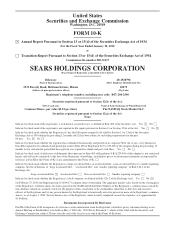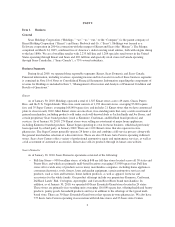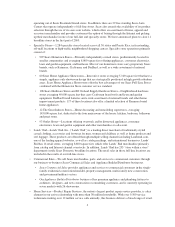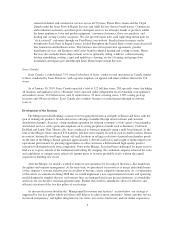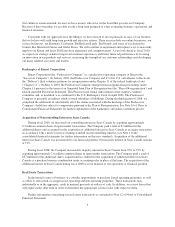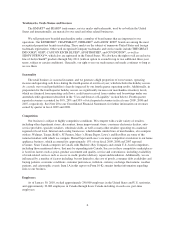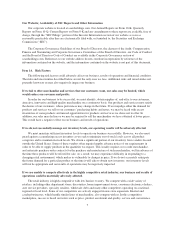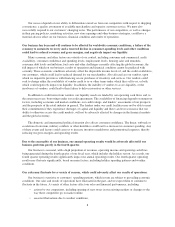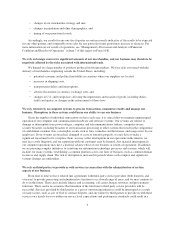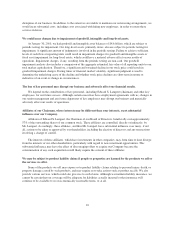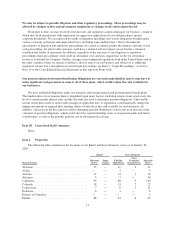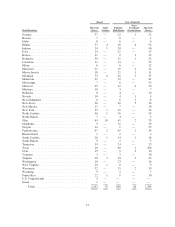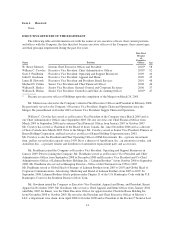Sears 2009 Annual Report Download - page 4
Download and view the complete annual report
Please find page 4 of the 2009 Sears annual report below. You can navigate through the pages in the report by either clicking on the pages listed below, or by using the keyword search tool below to find specific information within the annual report.related residential and commercial services across all 50 states, Puerto Rico, Guam and the Virgin
Islands under the Sears Parts & Repair Services and A&E Factory Service brand names. Commercial
and residential customers can obtain parts and repair services for all major brands of products within
the home appliances, lawn and garden equipment, consumer electronics, floor care products, and
heating and cooling systems categories. We also provide repair parts with supporting instructions for
“do-it-yourself” customers through our PartsDirect.com website. Smaller items for repair can be
brought into Sears Parts & Repair Centers located throughout the United States or into many Sears full-
line, hometown and hardware stores. This business also offers protection agreements, product
installation services and Kenmore and Carrier brand residential heating and cooling systems. Home
Services also includes home improvement services (primarily siding, windows, cabinet refacing,
kitchen remodeling, roofing, carpet and upholstery cleaning, air duct cleaning, and garage door
installation and repair) provided through Sears Home Improvement Services.
Sears Canada
Sears Canada, a consolidated, 73%-owned subsidiary of Sears, conducts retail operations in Canada similar
to those conducted by Sears Domestic, with a greater emphasis on apparel and other softlines than in the U.S.
stores.
As of January 30, 2010, Sears Canada operated a total of 122 full-line stores, 280 specialty stores (including
48 furniture and appliance stores, 186 dealer stores operated under independent local ownership, four appliance
and mattress stores, 30 Corbeil stores, and 12 outlet stores), 22 floor covering stores, 1,853 catalog pick-up
locations and 108 travel offices. Sears Canada also conducts business over the Internet through its website,
sears.ca.
Development of the Business
The Merger provided Holdings a means for leveraging the historical strengths of Kmart and Sears with the
goal of making our products, brands and service offerings available through more locations and customer
distribution channels. Sears has a long-standing reputation for offering customers a wide variety of merchandise
and related services, with a particular emphasis on its strong proprietary brands such as Kenmore, Craftsman,
DieHard and Lands’ End. Historically, Sears conducted its business primarily using a mall-based format. At the
time of the Merger, Sears operated 874 domestic full-line stores mainly located in such on-mall locations. Kmart,
in contrast, historically used large format, off-mall locations in selling a selection of general merchandise goods.
At the time of the Merger, Kmart operated approximately 1,400 off-mall stores and sought to further improve its
operational performance by pursuing opportunities to offer customers a differentiated high-quality product
selection to distinguish itself from competitors. Prior to the Merger, Sears had been challenged for many years to
find a way to grow outside of the traditional mall setting. By merging, the combined company achieved the scale
and capabilities to compete more effectively against many of its more profitable rivals, without the capital
required for building new stores.
After the Merger, we initially worked to improve our operations by focusing on the basics, like markdown
disciplines and expense management. At the same time, we prioritized our resources to merge and rebuild many
of the company’s systems and processes in an effort to become a more adaptable organization. As a continuation
of this effort, we announced during 2008 that we would implement a new organizational structure and operating
model designed to simplify the way our business lines are managed and create greater autonomy, accountability
and focus for our business unit management teams. Further, this model is intended to allow for effective and
efficient execution of the five key pillars of our strategy.
As discussed in more detail in the “Management Discussion and Analysis” section below, our strategy is
supported by five key pillars which we believe will help us to achieve more consistency, better customer service,
increased transparency, and tighter integration of our stores, our service businesses, and our online experiences.
4

